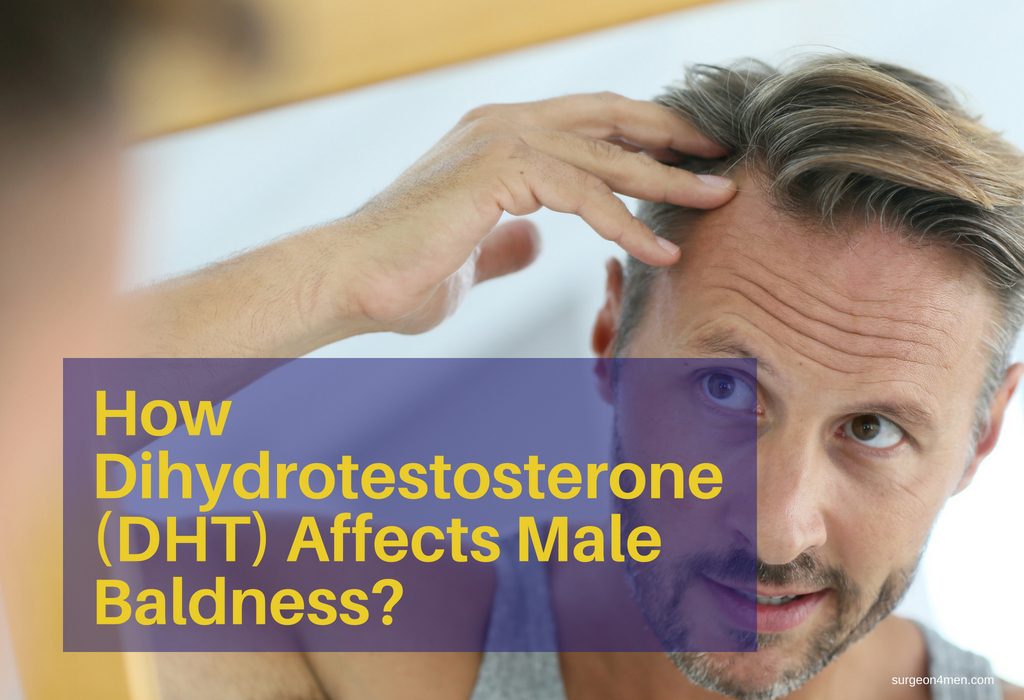How Dihydrotestosterone (DHT) Affects Male Baldness?
Male pattern baldness (also referred to as androgenic alopecia in sophisticated medical terms) is a serious concern among males of all age groups. It is a frequently reported problem that affects about 30% males in their 30’s; about 50% males in their 50’s and about 57% males over the age of 60 years.
Although the exact pathophysiology of early onset male pattern baldness is not fully known; investigators believe that there is a strong association with serum levels of dihydrotestosterone.
How does dihydrotestosterone lead to male pattern baldness?
Dihydrotestosterone is the active androgenic hormone that is responsible for manifesting male sexual characteristics. DHT is converted into its bioactive form with the help of an enzyme – called 5-alpha-reductase (5-AR). Males who are born with an inherent deficiency of this enzyme are at risk of developing a variety of disorders such as prostate irregularities and maldeveloped external genitalia. In some severe cases, the penis may be absent or look more like clitoris. Although such males are permanently infertile, they may manifest onset of secondary sexual characteristics at the time of puberty; such as deepening of voice and growth of facial or chest hairs.
Male Pattern Baldness – what else should you know about it?
Androgenic alopecia is marked by gradual thinning and eventual loss of scalp hair – that usually begins at the crown, ultimately involving the entire scalp.
In order to understand hair loss, it is important to understand hair growth physiology:
- Anagen: About 85% of the scalp hair remains in anagen phase at all times that lasts for about 2 to 6 years
- Catagen: The length of this phase is 2 weeks and involves renewal of the hair follicles
- Telogen: The length of this phase is up to 4 months and involves dormancy of hair follicles. About 15% of your scalp hair remains in this phase.
It is noteworthy that this hair growth cycle continues until hair grows and grow out of hair follicles; until the hair shed.
Androgenic alopecia on the other hand is characterized by diminution of hair follicle size as well as overall shortening of anagen phase and lengthening of telogen phase. This means that the total hair growth is reduced to a point that hair doesn’t even sprout beyond the surface of hair follicles. With shrinking of hair follicles, hair becomes weaker and thinner; ultimately looking like baby hair (villus)
It is imperative to mention that DHT has an opposite effect on har follicle receptors located in underarms, chest, face and pubic region.
How DHT promotes male patterns baldness?
Although the exact mechanism is not known; scientists have identified that the serum levels of DHT are much higher under the hair follicles obtained from the scalp of a balding person versus a person with normal scalp.
Some possible explanations of male pattern baldness caused by DHT are:
- Enhanced basal production of DHT by the scalp tissues
- Increased sensitivity of scalp androgen receptors to DHT
- Inherently higher density of DHT receptors on the scalp
- High serum levels of testosterone that may further enhance the activity od DHT
Since the conversion of testosterone into DHT under the influence of 5-alpha-reductase is responsible for androgenic alopecia; it has also been observed that hair thinning or hair loss doesn’t occur in males with the deficiency of this enzyme. Additionally, males who are suffering from male -pattern baldness can reduce the devastating hair loss with the use of drugs like 5-alpha-reductase inhibitors drugs (such as Finasteride).
Schedule an appointment with your primary care physician if you are experiencing hair thinning of male pattern baldness.
References:
- Caserini, M., Radicioni, M., Leuratti, C., Terragni, E., Iorizzo, M., & Palmieri, R. (2016). Effects of a novel finasteride 0.25% topical solution on scalp and serum dihydrotestosterone in healthy men with androgenetic alopecia. Int J Clin Pharmacol Ther, 54(1), 19-27.
- Heilmann-Heimbach, S., Herold, C., Hochfeld, L. M., Hillmer, A. M., Nyholt, D. R., Hecker, J., … & Heng, X. T. (2017). Meta-analysis identifies novel risk loci and yields systematic insights into the biology of male-pattern baldness. Nature Communications, 8, 14694.
